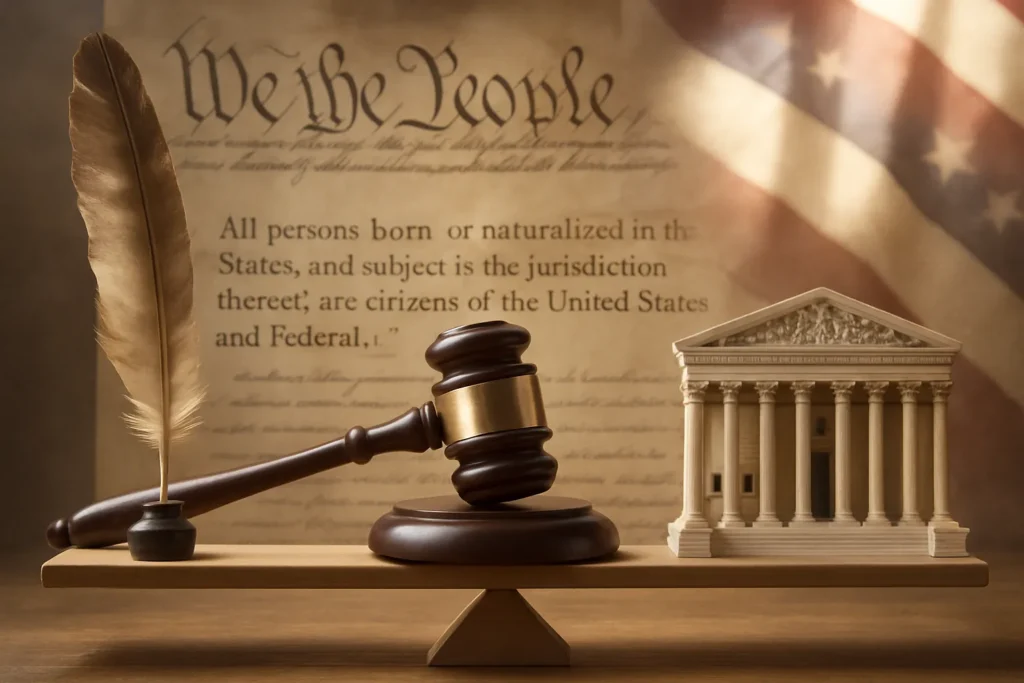Supreme Court Ruling Alters Judicial Powers
The U.S. Supreme Court has issued a significant ruling, deciding in a 6-3 vote to restrict the power of federal judges in issuing nationwide injunctions. This ruling directly affects President Donald Trump’s executive order aimed at ending birthright citizenship for children born to parents residing illegally in the United States. While the court’s decision does not rule on the constitutionality of Trump’s executive order itself, it significantly impacts how lower courts can respond, limiting their ability to broadly block such federal actions across the country. Now, injunctions can generally only apply to the immediate plaintiffs involved, creating varied implementation across different states.
The Supreme Court’s decision ends the practice of nationwide injunctions, creating potential for inconsistent legal protections. Justice Amy Coney Barrett authored the majority opinion, which specified that the federal judiciary exceeded its authority in applying nationwide restrictions regarding Trump’s citizenship directive. This ruling has opened the door for more localized litigation, meaning that states and plaintiffs that directly challenge federal orders may receive differing judgments.
Critics, including dissenting justices Sonia Sotomayor, Elena Kagan, and Ketanji Brown Jackson, warned of potential uneven enforcement and increased litigation burdens:
“This shift places the legal system and government in grave jeopardy and undermines the rule of law,” stated Justice Ketanji Brown Jackson in her dissent.
Immediately following the decision, President Trump praised the ruling on social media, calling it a significant legal victory for his administration. Conversely, immigrant advocacy groups expressed alarm over the potential confusion and disorder this decision might provoke nationwide.
States Respond with Varied Legal Actions
The Supreme Court’s decision has generated diverse reactions across various states, prompting immediate steps by state officials and attorneys general. California Governor Gavin Newsom and state Attorney General Rob Bonta publicly criticized the ruling, stressing their commitment to resisting what they perceive as an unconstitutional infringement on birthright citizenship guaranteed under the 14th Amendment.
New Jersey Attorney General Matt Platkin emphasized his state’s continued opposition to the executive order, highlighting concerns over the immediate practical implications. Platkin argued that the policy shift could lead to significant disruptions and inequities. New Jersey, along with 21 other states, previously filed lawsuits challenging the executive order, reflecting widespread legal resistance.
Meanwhile, in Texas, East Texas attorney Jose Sanchez explained that the Supreme Court’s decision significantly changes the judicial toolkit concerning federal policy oversight:
“The process started when President Trump challenged the traditional interpretation of the 14th Amendment,” Sanchez clarified, “and now federal judges will be considerably constrained in their ability to apply broad injunctions nationwide.”
As legal experts nationwide digest the implications, some states that have not joined lawsuits challenging Trump’s directive could see the birthright citizenship ban implemented within 30 days. Consequently, a patchwork of differing legal standards may emerge, potentially complicating administrative enforcement and individual rights.
Historical Context and Broader Implications
This latest Supreme Court ruling arrives amidst longstanding debates surrounding the 14th Amendment, adopted in 1868 following the Civil War. The amendment explicitly states that all persons born in the United States are citizens, historically protecting citizenship rights irrespective of parental legal status. Critics of Trump’s executive order argue that any attempt to dismantle birthright citizenship threatens a foundational constitutional guarantee.
Trump’s administration, however, positions its directive within the context of immigration reform, advocating for tightened control of citizenship parameters. With the directive now potentially enforceable in various jurisdictions, legal analysts anticipate a cascade of litigation as courts grapple individually with its constitutionality.
Additionally, this ruling aligns with increasing scrutiny of judicial power in recent Supreme Court terms. Critics argue that the curtailment of nationwide injunctions could weaken critical checks and balances, leaving executive actions less universally accountable. Proponents defend the decision as a necessary correction, constraining judicial overreach.
Broader policy implications are substantial as well, particularly regarding immigration and civil rights. Projections suggest that local courts may now regularly experience overloaded dockets, burdened with more cases challenging federal policies. Experts predict heightened complexity across legal, social, and political domains as localized judicial disparities multiply.
Paul Kastenberg, a constitutional scholar at the University of New Mexico School of Law, highlighted potential future challenges and legal uncertainty resulting from the ruling:
“Lower courts might now allow judges to interpret citizenship laws differently, creating vast legal uncertainties,” said Kastenberg, “potentially affecting millions of lives and fundamentally reshaping American immigration law.”
Looking forward, the debate over birthright citizenship is far from resolved. While the Supreme Court ruling has methodically limited judicial scope, the core constitutional issue remains undecided, pending further litigation and probable future deliberations at the Supreme Court level. For now, key stakeholders on both sides of the argument prepare for intensified state-specific legal battles, which could redefine immigration rights and judicial authority in America.


